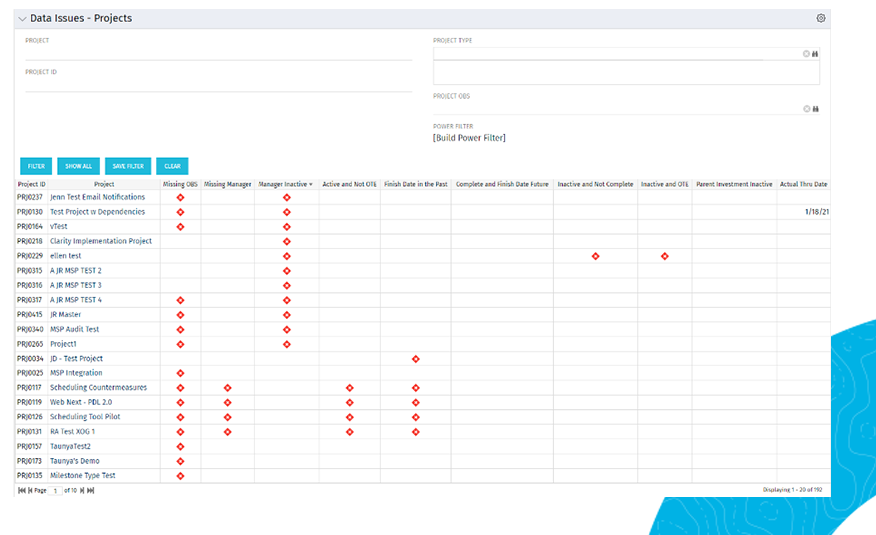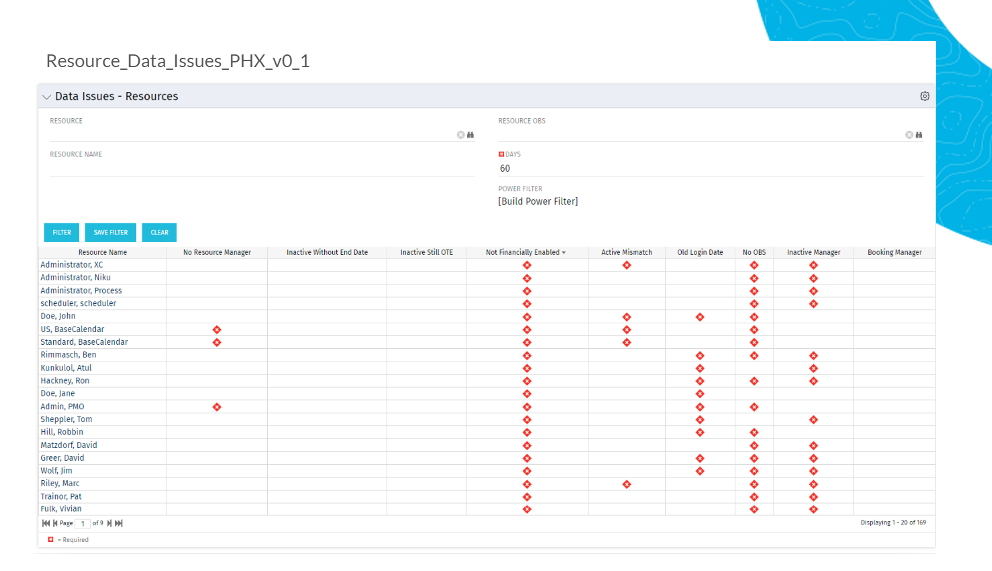
Resources with No Basic Matrix Entry
Available for free in theBasiX: Oracle | Postgres | SQL server
If your organization uses Clarity for project financial management, then you will no doubt be familiar with ‘Invalid Transactions’ and how important it is to ensure these problematic transactions are corrected, so that your financial data remains current and up to date.
One thing I see all the time, when working with my clients, are invalid transactions that crop up because a resource has logged time on their timesheet, but there is no associated rate in the matrix for that resource.
This is where the portlet ‘Resources with No Basic Matrix Entry’ becomes your best friend. It’s a combination of an NSQL query, attached to a grid portlet, which will show you resources who have been allocated to a project team (i.e., they are on the Team tab in Classic or the Staff tab in Modern) but who do not have a corresponding rate in the rate matrix.
Once the portlet is up and running, it will allow you to filter by project, resource, or missing rate(s). The best way to manage this data is to regularly review this page and set your Missing Rate filter option to ‘Yes’. This will show you all the problematic rows that need remediating. From here you can add the necessary rates to your rate matrix and keep adding rates until you have no rows displayed on this page.
If you see rows on this page, you know there is work to do.

Project Data Issues
Available for free in theBasiX: Oracle | Postgres | SQL server
I often see that it takes time for clients to build up their project maturity and set up adequate checks and balances when it comes to project data hygiene. This portlet serves as a great tool to highlight problematic projects which require further review and attention.
As an example, this portlet will help you to identify when a project is missing data, such as OBS or a Manager. It will even tell you if the project manager assigned to your project is no longer active in the system.
It will also indicate if a project has a finish date that is in the past and the Progress has not yet been set to Complete. Conversely, if your project is already set to Complete but the Finish date is in the future, these will also be flagged for review.
There are numerous other data exception warnings that this handy portlet provides. Usually, I find most clients will implement the portlet as is, but then engage with Rego to add further data discrepancy checks as they identify areas of interest, which align to their project methodologies and frameworks.
There are numerous filtering options, such as project name, ID or OBS. Plus, you can also filter by project type. For example, you can filter out BAU (Business As Usual) or maintenance type projects.

Resource Data Issues
Available for free in theBasiX: Oracle | Postgres | SQL server

It provides valuable insights to organizations who do not currently have an interface with their authentication systems, but can also provide benefits to organizations that already do.
For example, if there is no authentication integration set up, this portlet will let you know if there are resources who do not have a resource manager assigned, and will also indicate when an assigned resource manager has been deactivated in the system.
When either of these warnings are flagged, you should make sure you confirm who is the applicable resource manager for the resource and ensure their record is updated. There is also a flag to indicate when a resource does not have a Booking Manager listed. If your company is using Requisitions (in Classic) then you must have a Booking Manager in order for the requisitions to be assigned to the correct manager. So, if you are using requisitions and you notice this field is blank, make sure you update as soon as possible.
This portlet will also show resources that have been deactivated, but do not have a termination date set on their resource record. Many Clarity administrators do not realize that setting a termination date on a resource record will ensure that you cannot add allocations for the resource after this date. The system actually has in-built functionality which will prevent you from allocating work to resources that are no longer employed. This portlet will help ensure you do not waste time by incorrectly allocating work and that projects are correctly staffed with current resources.
This portlet will also alert you when a resource is inactive but still open for time entry. Which is useful, particularly when you have team members lodging time on behalf of other resources. It helps to ensure the quality of timesheet data.
In terms of financials, the portlet will also highlight when a resource is not financially enabled. This may not always be an issue, particularly when a company is still growing their financial management capabilities. However, if your organization is posting timesheets and using the Clarity rate matrix to calculate labor costs, then a quick check of this data will help to prevent many invalid transactions.
The Active Mismatch column will show you when there is a discrepancy between the active setting under the Administration > Resources menu item and the active flag under Home > Resources. Now, this is not always an issue, as there may be times when a resource needs to be visible in drop down lists, but does not actually need to log into the system. But, most resources would usually be required to be active in both the Home and Administration menus.
The Old Login Date field will evaluate the value that you entered into the ‘Days’ filter attribute and count back from the current date. If the last login date for any user is prior to this calculated date, then this resource will be flagged. This can help you identify individuals who have not been using Clarity regularly.
The No OBS (Organizational Breakdown Structure) flag simply tells you when the resource does not have an OBS (Department/Team) added to their resource record. A lack of OBS data against resource records can cause all sorts of issues when it comes to resource allocations and capacity planning, so if this flag is triggered, it is best to fix the issue right away.

This content is available for Oracle, Postgres and SQL Server.
Getting Started in RegoXchange
 If you would like get yourself set up and start browsing all the helpful Clarity content that is available, go to RegoXchange and register today. On the registration page, you will find instructions on how to sign up for a free theBasiX account or gain access to additional content with a paid theWorX account subscription.
If you would like get yourself set up and start browsing all the helpful Clarity content that is available, go to RegoXchange and register today. On the registration page, you will find instructions on how to sign up for a free theBasiX account or gain access to additional content with a paid theWorX account subscription.
If you are interested in learning more about RegoXchange, or Clarity in general, Rego can guide you.
Our experienced, real-world practitioners have helped organizations of all sizes and industries implement solutions and get even more value from their Clarity solution. To learn more, contact us or reach out to your Rego Account Manager.


 If yes, then you know how valuable this tool can be and how much time it can save when searching for both simple and complex solutions within Clarity.
If yes, then you know how valuable this tool can be and how much time it can save when searching for both simple and complex solutions within Clarity.








